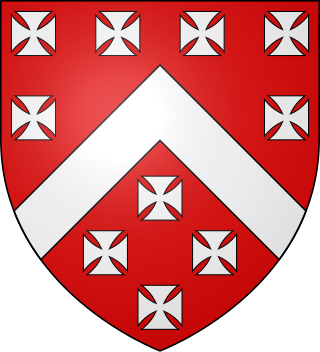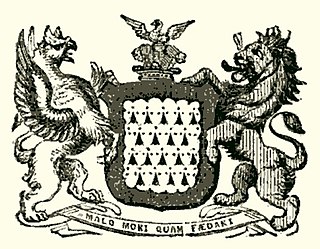
Baron Trimlestown, of Trimlestown in County Meath, was a title in the Peerage of Ireland. Following the death of the 21st Baron in January 2024 with no known heir, the title is dormant, and may be extinct. [2]

Baron Trimlestown, of Trimlestown in County Meath, was a title in the Peerage of Ireland. Following the death of the 21st Baron in January 2024 with no known heir, the title is dormant, and may be extinct. [2]
The title was created in 1461 for Sir Robert Barnewall, who was the younger brother of Nicholas Barnewall, Chief Justice of the Irish Common Pleas, and younger son of Sir Christopher Bernevall, Lord Chief Justice of the King's Bench in Ireland. He married Elizabeth le Brun, the heiress of Roebuck Castle in South Dublin. He was succeeded by his son Christopher, the second Baron. Christopher was implicated in the Lambert Simnel conspiracy, but received a royal pardon in 1488. His son John, the third Baron, served as Lord Chancellor of Ireland from 1534 until his death in 1538. The tenth baron, Matthias Barnewall, was attainded in 1691 for supporting the Jacobite cause, but his brother successfully recovered the title and family estate. [3]
The barony became dormant on the death of the sixteenth Baron, in 1879. In 1891 the peerage was claimed by Christopher Patrick Mary Barnewall (de jure 17th Baron Trimlestown), a descendant of Hon. Patrick Barnewall, second son of the seventh Baron. He died before he had fully established his claim, but in 1893 his younger brother Charles Aloysius Barnewall was confirmed in the title by the Committee for Privileges of the House of Lords.
As of 2013 [update] the title was held by the grandson of the successful claimant of 1893, the twenty-first Baron, who succeeded his elder brother in 1997. There being no known heir to the barony, on the death of the 21st Baron on 10 January 2024, the title became dormant, and may be extinct, unless a remote heir is found. [2]
The Viscounts Barnewall were members of another branch of the Barnewall family and a third branch were the Barnewall baronets of Crickstown.

There is no known heir to the barony.


Earl Castle Stewart, in the County Tyrone, is a title in the Peerage of Ireland. It was created in 1800 for Andrew Thomas Stewart, 9th Baron Castle Stuart.

Viscount Cobham is a title in the Peerage of Great Britain that was created in 1718. Owing to its special remainder, the title has passed through several families. Since 1889, it has been held by members of the Lyttelton family.

Baron FitzWalter is an ancient title in the Peerage of England. It was created on 24 June 1295 for Robert FitzWalter. The title was created by writ, which means that it can descend through both male and female lines.

Baron de Clifford is a title in the Peerage of England. It was created in 1299 for Robert de Clifford (c.1274–1314), feudal baron of Clifford in Herefordshire, feudal baron of Skipton in Yorkshire and feudal baron of Appleby in Westmoreland. The title was created by writ, which means that it can descend through both male and female lines. The Norman family which later took the name de Clifford settled in England after the Norman Conquest of 1066 and was first seated in England at Clifford Castle in Herefordshire. The first Baron served as Earl Marshal of England but was killed at the Battle of Bannockburn in 1314. His 8th generation descendant the 11th Baron, was created Earl of Cumberland in 1525, whose grandson the 3rd Earl was a noted naval commander. On the latter's death in 1605, the earldom passed to his younger brother, the 4th Earl.

The title Baron Berkeley originated as a feudal title and was subsequently created twice in the Peerage of England by writ. It was first granted by writ to Thomas de Berkeley, 1st Baron Berkeley (1245–1321), 6th feudal Baron Berkeley, in 1295, but the title of that creation became extinct at the death of his great-great-grandson, the fifth Baron by writ, when no male heirs to the barony by writ remained, although the feudal barony continued. The next creation by writ was in 1421, for the last baron's nephew and heir James Berkeley. His son and successor William was created Viscount Berkeley in 1481, Earl of Nottingham in 1483, and Marquess of Berkeley in 1488. He had no surviving male issue, so the Marquessate and his other non-inherited titles became extinct on his death in 1491, whilst the barony passed de jure to his younger brother Maurice. However, William had disinherited Maurice because he considered him to have brought shame on the noble House of Berkeley by marrying beneath his status to Isabel, daughter of Philip Mead of Wraxhall, an Alderman and Mayor of Bristol. Instead, he bequeathed the castle, lands and lordships comprising the Barony of Berkeley to King Henry VII and his heirs male, failing which to descend to William's own rightful heirs. Thus on the death of King Edward VI in 1553, Henry VII's unmarried grandson, the Berkeley inheritance returned to the family. Therefore, Maurice and his descendants from 1492 to 1553 were de jure barons only, until the return of the title to the senior heir Henry, becoming de facto 7th Baron in 1553. Upon his death he was succeeded by his relative George Harding.

Baron Saye and Sele is a title in the Peerage of England held by the Twisleton-Wykeham-Fiennes family. The title dates to 1447 but it was recreated in 1603. Confusion over the details of the 15th-century title has led to conflicting order for titleholders; authorities such as Burke's Peerage and Debrett's Peerage do not agree on whether or not the 1447 creation is still extant.

Viscount Gormanston is a title in the Peerage of Ireland created in 1478 and held by the head of the Preston family, which hailed from Lancashire. It is the oldest vicomital title in the British Isles; the holder is Premier Viscount of Ireland.

The title Baron of Dunsany or, more commonly, Lord Dunsany, is one of the oldest dignities in the Peerage of Ireland, one of just a handful of 13th- to 15th-century titles still extant, having had 21 holders, of the Plunkett name, to date. Other surviving medieval baronies include Kerry, Kingsale, Trimlestown (1469), Baron Louth, and Dunboyne.
The title Baron Bergavenny was created several times in the Peerage of England and once in the Peerage of Great Britain, all but the first being baronies created by error. Abergavenny is a market town in South East Wales with a castle established by the Norman lord Hamelin de Balun c. 1087.

The Barnewall Baronetcy, of Crickstown Castle in the County of Meath, is a title in the Baronetage of Ireland. It was created on 21 February 1623 for Sir Patrick Barnewall. He was the member of a family that had been settled in Ireland since 1172, when Sir Michael de Berneval landed on the coast of Cork. The second and third Baronets both represented County Meath in the Irish House of Commons. The fifth Baronet, a descendant of the second son the first Baronet, established his right to the title in 1744. However, his cousin Thomas Barnewall, de jure sixth Baronet, never assumed the title and it remained dormant from his death in 1790 until 1821, when it was successfully claimed by Robert Barnewall, the eighth Baronet.

Robert Barnewall, 12th Baron Trimlestown was a prominent Anglo-Irish landowner, active in the Roman Catholic cause.
Thomas Fleming was an Irish peer, and a member of the Parliament of Ireland of 1585. He was the son of James Fleming, and great-grandson of James Fleming, 7th Baron Slane. His mother was Ismay Dillon, daughter of Sir Bartholomew Dillon, Lord Chief Justice of Ireland and his first wife Elizabeth Barnewall; after his father's death she remarried Sir Thomas Barnewall of Trimlestown.

Baron Willoughby of Parham was a title in the Peerage of England with two creations. The first creation was for Sir William Willoughby who was raised to the peerage under letters patent in 1547, with the remainder to his heirs male of body. An error in identifying the heir in 1680 resulted in an inadvertent novel creation by writ in 1680, without the restriction on inheritance by gender. The creation of the barony gave the right to a hereditary peerage and seat in the House of Lords, the upper house of Parliament.
Sir Bartholomew Dillon was a leading Irish judge of the sixteenth century who held the offices of Chief Baron of the Irish Exchequer and Lord Justice of Ireland.
Patrick Barnewall was a leading figure in the Irish Government of the 1530s and 1540s. He owed his position largely to his close links with Thomas Cromwell. He sat in the Irish House of Commons as MP for County Dublin, and held the offices of Solicitor General for Ireland and Master of the Rolls in Ireland. Today he is mainly remembered for his role in founding the King's Inns. He belonged to a junior branch of the family of Lord Trimlestown: his own descendants held the title Viscount Barnewall of Kingsland.
James Dillon, 1st Earl of Roscommon fought for the crown in the Nine Years' War. He was ennobled despite being a Catholic after his son Robert turned Protestant.
Baron Galtrim was an Irish feudal barony: in other words, the holder of the barony, which was hereditary in the Hussey family, was entitled to style himself Lord Galtrim, but was not entitled as of right to sit in the Irish House of Lords, although at least two holders of the title did receive a summons to sit in Parliament, and a third sat in the House of Commons. The title was created in the late fourteenth century by summons to Parliament. Use of the title lapsed in the early nineteenth century: from then on the former Lord Galtrim was usually referred to simply as "Mr. Hussey of Rathkenny".

Nicholas Barnewall, 14th Baron Trimlestown was an Irish landowner associated with the Roebuck Estate in County Dublin, Ireland. He was the son of Richard Barnewall, a younger brother of Robert Barnewall, 12th Baron Trimlestown, and his wife and distant cousin Frances Barnewall, daughter of Nicholas Barnewall, 3rd Viscount Barnewall and Mary Hamilton. He succeeded to his title on the death of his cousin Thomas in 1796.

Thomas Barnewall, 16th Baron Trimlestown was an Irish landowner associated with the Roebuck Estate in County Dublin, Ireland.
Matthias Barnewall, 10th Baron Trimlestown was an Irish Jacobite peer and soldier.